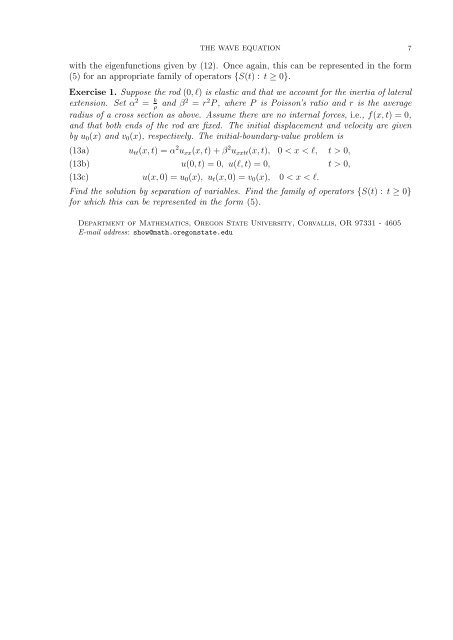THE WAVE EQUATION 1. Longitudinal Vibrations We describe the ...
THE WAVE EQUATION 1. Longitudinal Vibrations We describe the ...
THE WAVE EQUATION 1. Longitudinal Vibrations We describe the ...
You also want an ePaper? Increase the reach of your titles
YUMPU automatically turns print PDFs into web optimized ePapers that Google loves.
<strong>THE</strong> <strong>WAVE</strong> <strong>EQUATION</strong> 7with <strong>the</strong> eigenfunctions given by (12). Once again, this can be represented in <strong>the</strong> form(5) for an appropriate family of operators {S(t) : t ≥ 0}.Exercise <strong>1.</strong> Suppose <strong>the</strong> rod (0, l) is elastic and that we account for <strong>the</strong> inertia of lateralextension. Set α 2 = k and ρβ2 = r 2 P , where P is Poisson’s ratio and r is <strong>the</strong> averageradius of a cross section as above. Assume <strong>the</strong>re are no internal forces, i.e., f(x, t) = 0,and that both ends of <strong>the</strong> rod are fixed. The initial displacement and velocity are givenby u 0 (x) and v 0 (x), respectively. The initial-boundary-value problem is(13a)(13b)(13c)u tt (x, t) = α 2 u xx (x, t) + β 2 u xxtt (x, t), 0 < x < l, t > 0,u(0, t) = 0, u(l, t) = 0, t > 0,u(x, 0) = u 0 (x), u t (x, 0) = v 0 (x), 0 < x < l.Find <strong>the</strong> solution by separation of variables. Find <strong>the</strong> family of operators {S(t) : t ≥ 0}for which this can be represented in <strong>the</strong> form (5).Department of Ma<strong>the</strong>matics, Oregon State University, Corvallis, OR 97331 - 4605E-mail address: show@math.oregonstate.edu
















